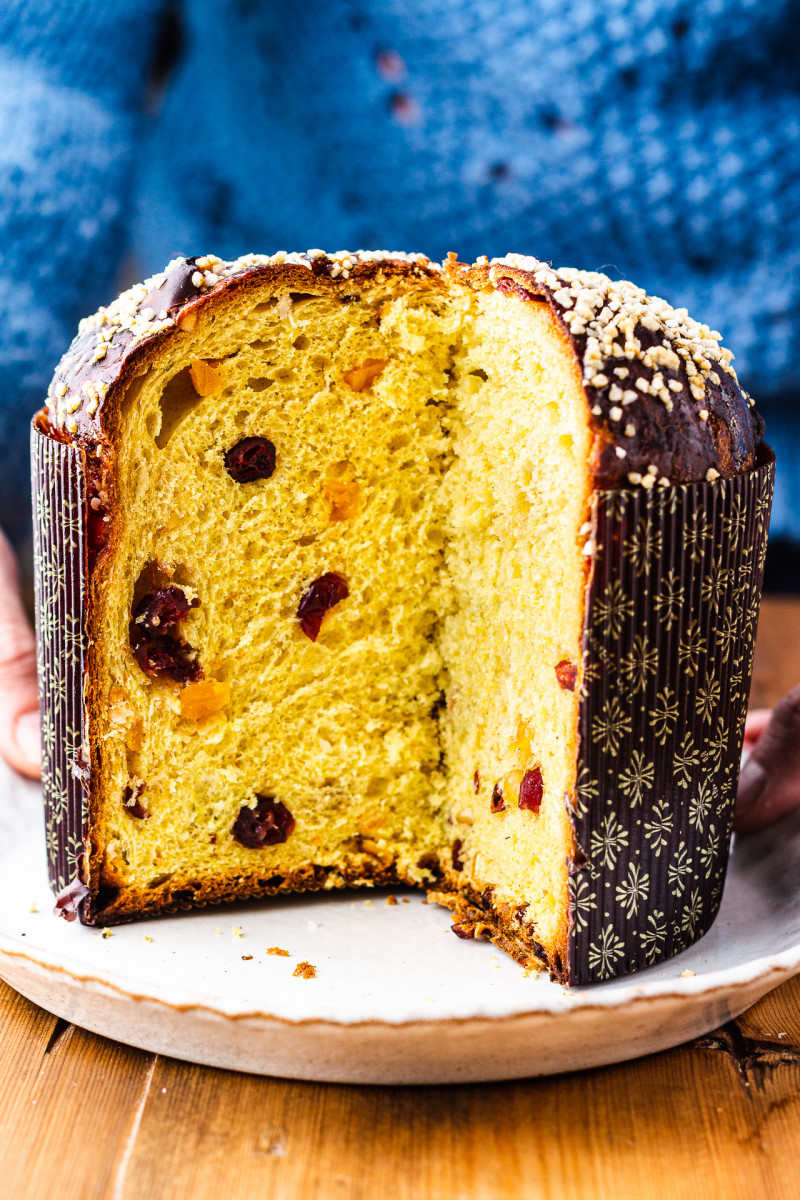
This vegan panettone recipe is dedicated to one of my lovely readers – Lara – who emailed me a few weeks ago asking if I could come up with one. I promised I would do my best and here is the result of my trial and error.
I must say that not only has it surpassed my expectations, but I also had a lot of fun creating this recipe so thank you to Lara for nudging me in that direction. I hope she and her Italian family approve.
This vegan panettone is a great pre-Christmas project as it can sit around for a few days locked away in an airtight box. Even if it does dry out a little bit, it will make a delightful Christmas breakfast, lightly toasted and served with cold butter. Yuuuuum.
Traditional panettone is a very labour intensive thing to make and while this vegan panettone is streamlined somewhat, it still requires commitment. Traditional panettone is made with a dry sourdough starter that is refreshed three times before it is added to the first panettone dough.
As I wanted this vegan panettone to be more accessible I made it with commercial yeast. I used instant yeast as they require least fuss. The night before you intend to make your panettone, you combine a touch of yeast with some flour and water and leave it to sit on the counter overnight to do its thing. Next morning you can crack on with the dough.
In terms of whether you can make this vegan panettone by hand the answer is YES, absolutely, but it’s not a walk in the park. Especially once you start incorporating butter you are in for at least 30 minutes of continuous kneading and it does get messy (see photos here). If that does not scare you and you don’t have a standing mixer, absolutely go ahead. Otherwise dust your mixer off and your are ready to crack on.
While vegan panettone may be a bit of an undertaking, it so rewarding! It fills the kitchen with the most delectable Christmas smell and the end product is mighty addictive! I did not even think that I liked panettone – I’ve never had one that was so fresh, but I could not resist cutting myself a slice after slice with my afternoon coffee. I knew this was going nowhere good so I took two panettone to my dance group Christmas party and it was received with much love despite hardly anyone knowing it is vegan – that’s always a good sign, isn’t it? I hope you will give it a go and if you are having any doubts, message me on Instagram (@lazycatkitchen) and I will get back to you as quickly as I can.
MORE ABOUT THE INGREDIENTS
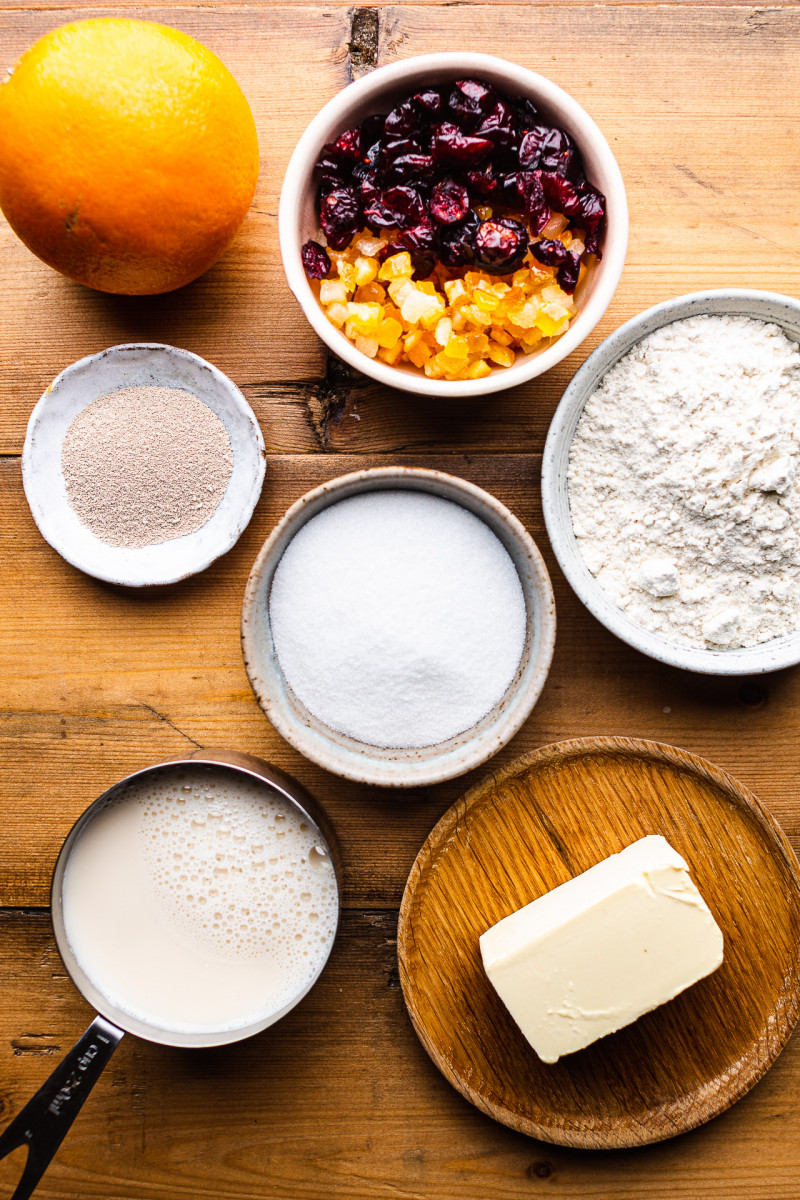
FLOUR: Panettone is a type of bread, it’s sweet and buttery but it’s still bread nevertheless, I therefore recommend using a high protein bread flour for the best result. Panettone dough is a type of enriched dough and all that butter and sugar that is added hinders gluten development so using bread flour helps with that.
YEAST: Yeast is what gives this sweet festive bread rise and a lovely, fluffy texture. Traditional panettone is made with an ancient sourdough starter, but since not everyone has a starter I decided to make this vegan panettone recipe more accessible by using commercial yeast. I used instant yeast, also known as fast acting dry yeast in the UK, and that’s what I recommend. It’s widely available and could not be easier to use.
SOY MILK: I used barely warmed up soy milk to add moisture to the dough and to partially replace eggs. You can probably use any other plant milk if you are allergic to soy, but I’ve only ever tested with soy milk.
SUGAR: Panettone dough is lightly sweetened, it’s not meant to be sweet like a cake but just tiny bit sweet so I added 90 g (3.2 oz) of sugar to the dough to sweeten it. I used superfine white sugar, known as caster sugar in the UK as its tiny particles are best at dissolving quickly. I also used another type of sugar – pearl sugar – to decorate the bread. It looks pretty and it adds a nice crunch on top, but if it’s impossible to get where you live simply use untoasted almond flakes instead!
VEGAN BUTTER: Traditional panettone uses butter and eggs to enrich the dough. As this is a vegan panettone, I replaced butter with vegan butter and I increased its amount to compensate forbthe fact that traditionally used egg yolks also contribute fat to the dough. I used Danish brand Naturli, which is available in Sainsbury’s and Waitrose supermarkets in the UK, but any vegan butter block that isn’t salted will work just as well.
CITRUS: Traditional panettone contains plenty of citrus zest. I went for orange zest from two large oranges, but you could also use one orange and one lemon or two lemons if that’s what you prefer.
VANILLA: Vanilla is traditionally added to this festive bake, I used vanilla paste but any form of vanilla would work well.
MIX-INS: A good traditional panettone contains a generous amount of mix-ins as so this vegan panettone is no different. Traditional additions are raisins, candied orange and lemon rind and sometimes nuts. I went for cranberries, candied orange and ginger and chopped apricots. Some people like chocolate chips! You can add anything as long as it does not contribute moisture. If you use dry additions like raisins, soften them in a liquid of choice first so that they don’t suck the moisture away from the dough. Be sure to squeeze excess moisture out of them before adding them to the dough.
HOW TO MAKE IT?
1) MAKE BIGA THE NIGHT BEFORE
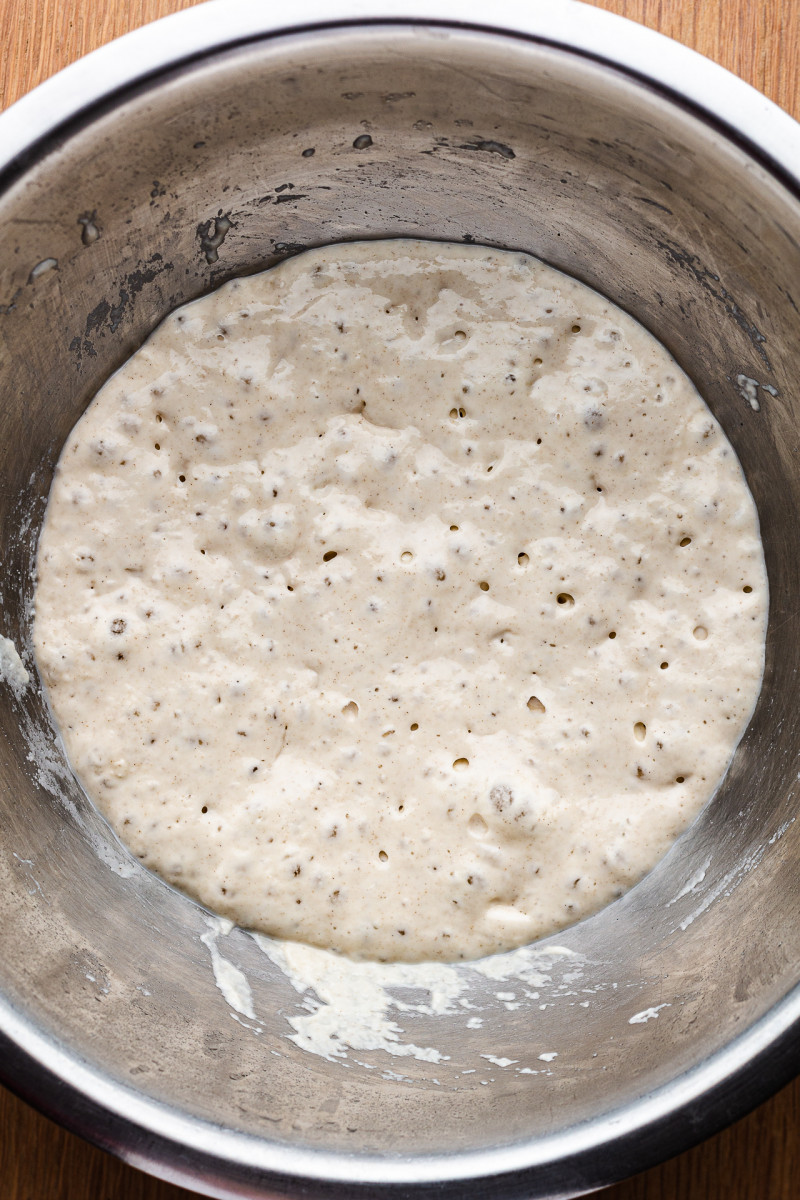
In a medium bowl combine flour, small amount of yeast and water. Mix really well and let sit on the counter overnight until lots of bubbles show up on the surface.
2) FIRST DOUGH
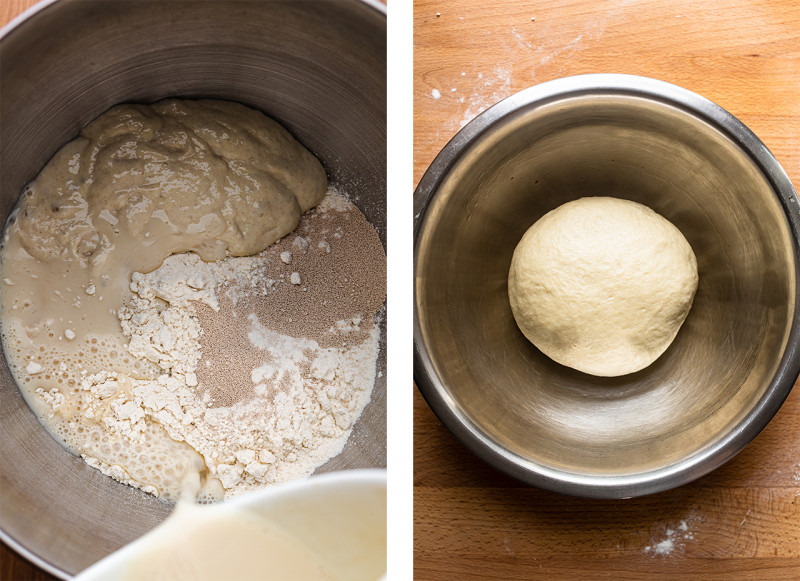
The morning after, combine biga with bread flour, yeast and lukewarm soy milk. Knead until elastic and smooth. Place in a clean bowl, cover with a tea towel and set aside to double in size – how long it will take depends on the ambient temperature but don’t be tempted to speed things up by leaving the dough close to a heater or other source of intense heat as this may kill the yeast and ruin you panettone.
3) SECOND DOUGH
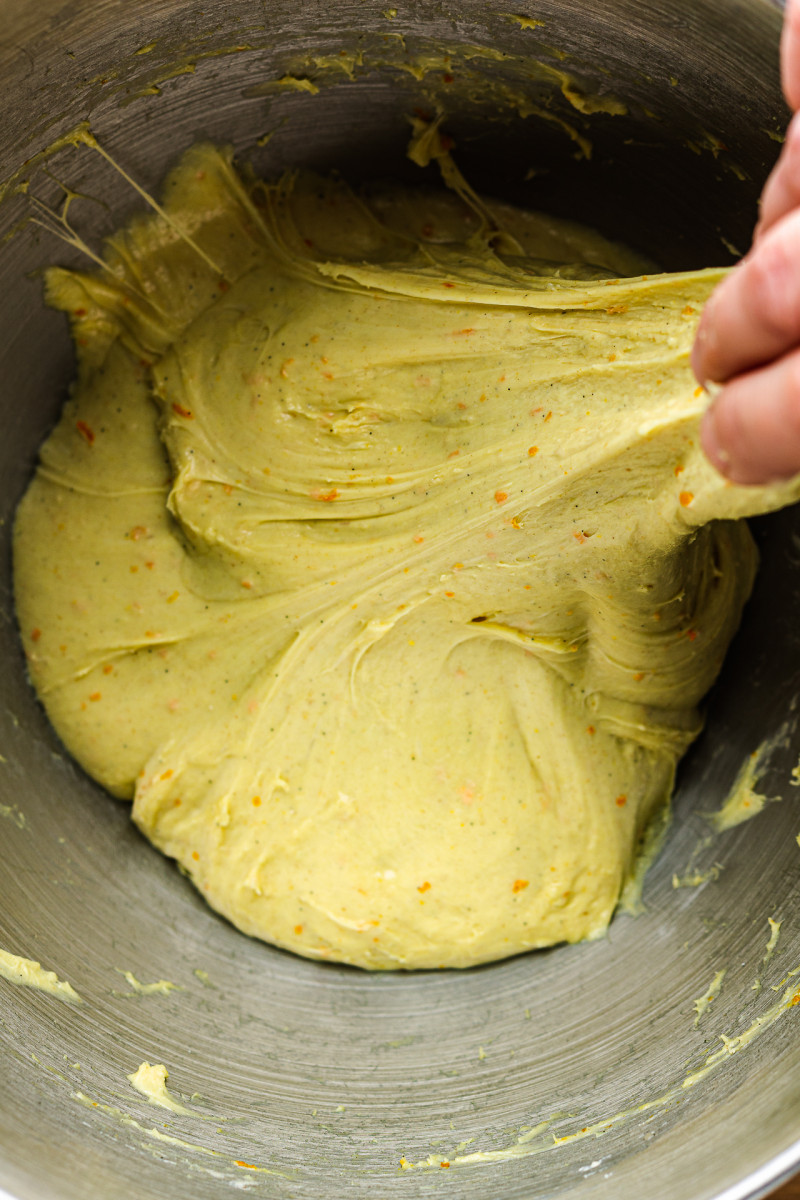
Once the first dough has risen, place it back in the bowl of electric mixer or on a stone counter (wood does not work that well) if kneading by hand. First incorporate all of the sugar and then gradually, tablespoon by tablespoon, add room temperature butter. Do not add the next portion until the first has been fully incorporated.
By the time all of the butter has been incorporated your dough should be smooth, shiny and very elastic – it should pass windowpane test (i.e. a semi transparent membrane should form when you stretch a portion of it gently between your hands).
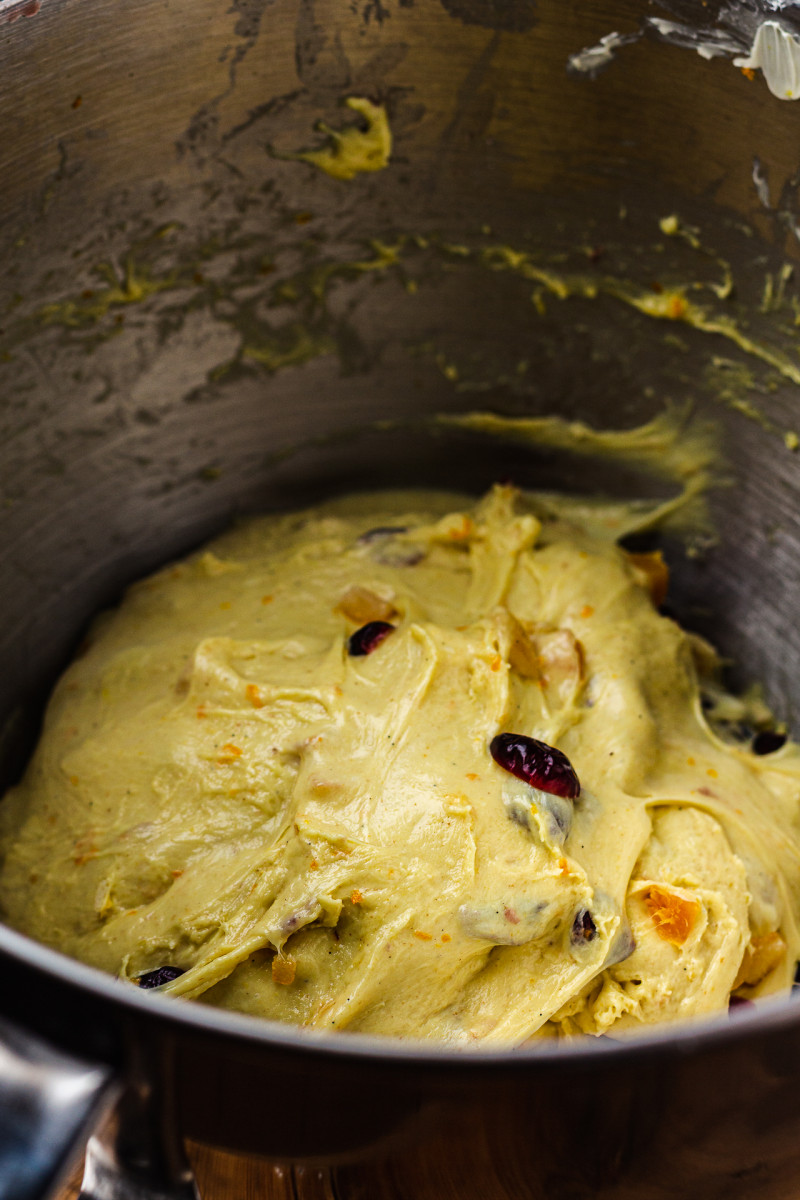
Add salt, orange zest, vanilla and all of the mix-ins. If you are incorporating the mix-ins by hand, stretch the dough out on a lightly oiled countertop as much as possible, scatter all of the mix-ins on top (it will be very crowded!!), then fold the dough over the mixings. Keep on folding until well incorporated. Set aside for another proof – until at least doubled in size.
4) SHAPE & PROOF
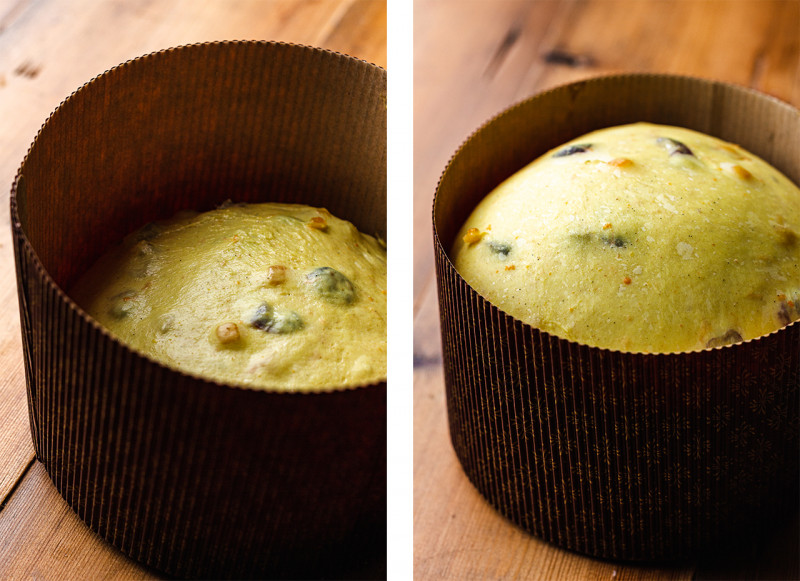
Once the dough has risen for the second time, stretch and fold it a couple of times and shape into a round. Place in a lightly oiled panettone mould and allow to rise for the last time, until the highest point of the dough has reached the top of the paper mould. My mould is a traditional Italian 750 g / 26.5 oz mould, which is 11 cm / 4.3 inches tall and has a 15 cm / 6 inches dia across the base.
4) GLAZE, SCORE AND BAKE
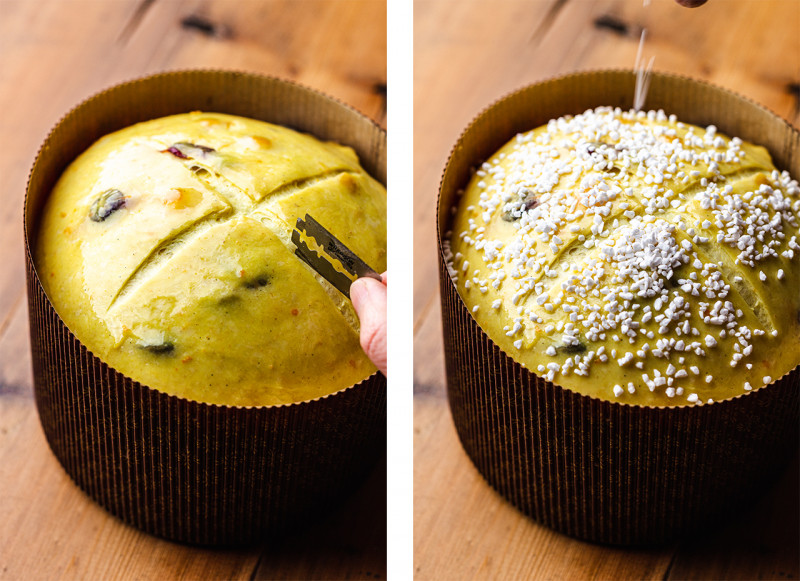
Before you are ready to bake your vegan panettone, plan on how to suspend your panettone upside down after baking – this is done so that panettone does not collapse onto itself when cooling so that the inside remains light and fluffy. Glaze your panettone, make a cross incision on top and sprinkle with pearl sugar or flaked almonds for decoration. Bake for about an hour tenting the top with a piece of kitchen foil at about half way point. As soon as it comes out of the oven, it needs to be suspended upside down. I did that by piercing the bottom of the mould and panettone (about 1 cm / 0.4″ off the bake with sharp metal BBQ skewers), gently turning upside down and suspending it between two massive IKEA storage jugs.
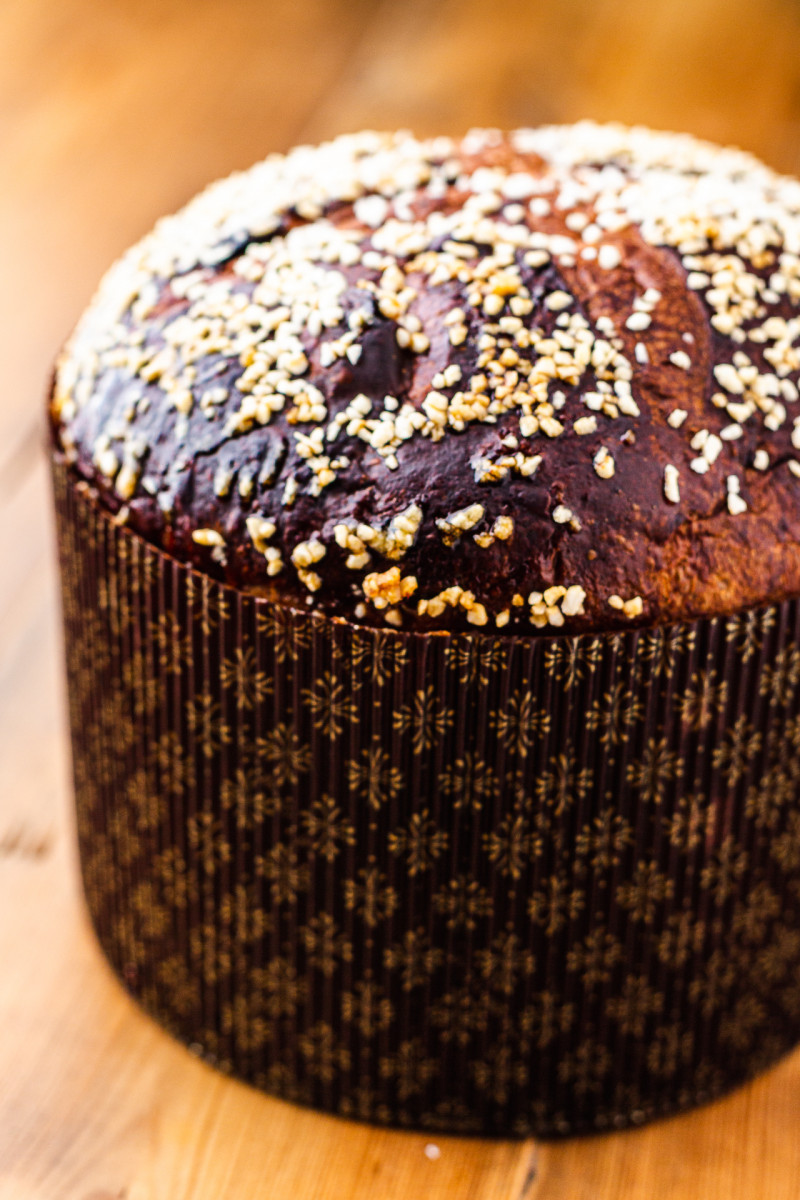
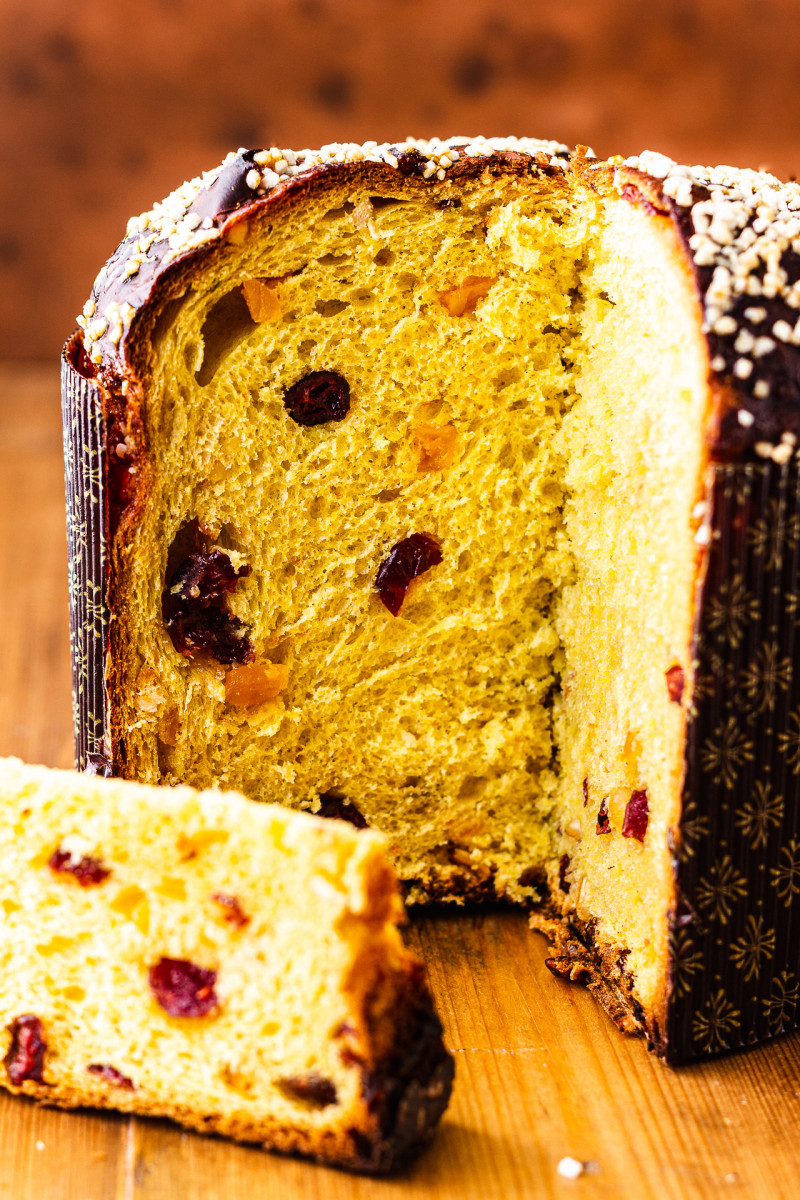
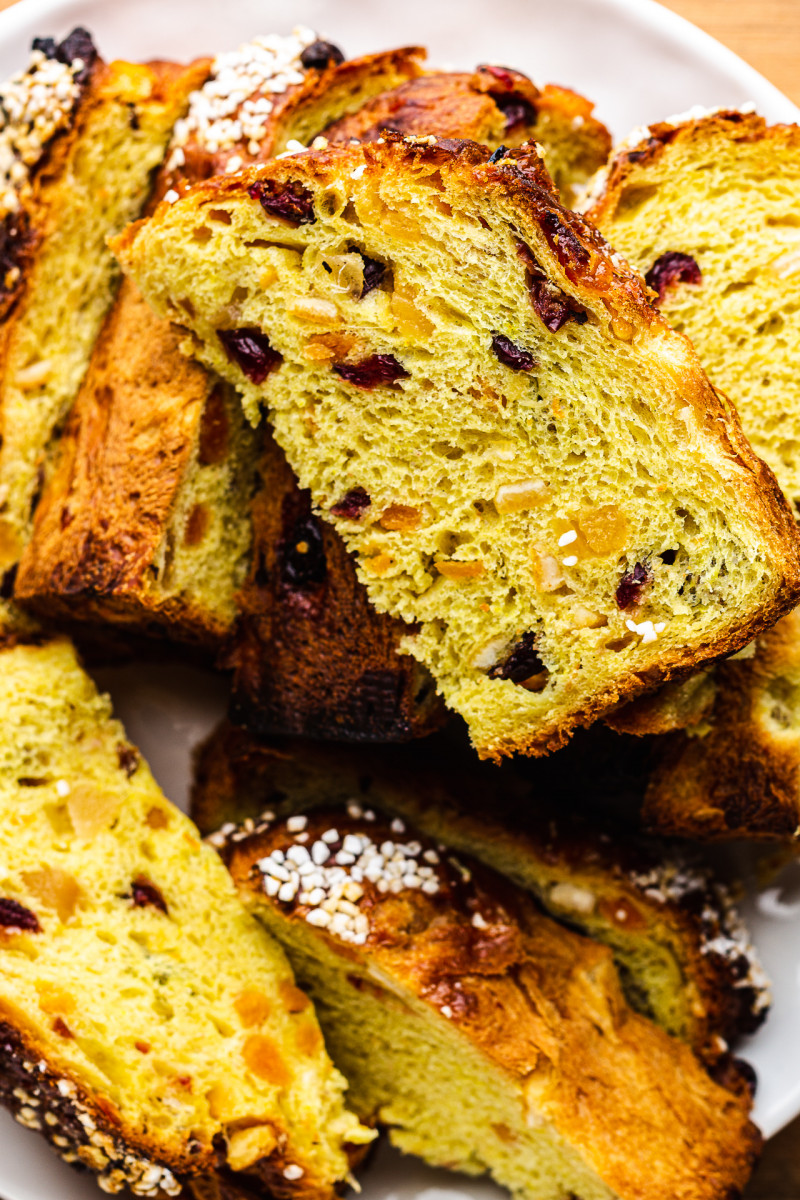

BIGA
- 90 g / ¾ cup wheat flour (all purpose is fine)
- 1/8 tsp instant (fast action) yeast
- water
FIRST DOUGH
- 250 g / 2 cups bread flour*
- 180 ml / ¾ cup lukewarm soy milk
- 10 g / 1 tbsp instant (fast action) yeast
SECOND DOUGH & MIXINGS
- 90 g / scant ½ cup caster (superfine) sugar
- 100 g / 3.5 oz (½ cup) room temp vegan butter
- ¾ tsp fine salt
- 2 tsp vanilla paste
- 1/16 tsp turmeric, for colour (optional)
- zest of 2 oranges (or 1 orange & 1 lemon)
- 60 g / ½ cup dried cranberries or raisins
- 60 g / ½ cup candied orange or mixed peel
- 60 g / ½ cup crystalised ginger pieces*
- 60 g / ½ cup diced dried apricots
GLAZE
- 5 ml / 1 tsp maple syrup (or dissolved sugar)
- 10 ml / 2 tsp mild olive oil
- 15 ml / 1 tbsp soy milk
- pearl sugar or almond flakes, to decorate (optional)
BEFORE YOU START…
- Make sure you have a 750 g / 26 oz panettone mould (mine is 11 cm / 4.3 inches tall and has a 15 cm / 6 inches dia across the base) ready or improvise with a cake tin and triple folded baking paper.
- Ensure you have a couple of metal skewers and two tall objects (I used two massive IKEA jars) to suspend turned upside down panettone between them as soon as it finishes baking or get creative and come up with your own way of suspending panettone upside down.
BIGA
- The night before combine flour, instant yeast and 74 g (1/3 cup) of lukewarm water. Mix very well, cover with cling film and let it sit on the counter overnight.
- If you are planning on using raisins or something else that is dry in your panettone, submerge them in liquid to soften or else they will absorb moisture from the dough. Orange juice, sweet alcohol (Amaretto, for example) or even water works well. Set aside overnight.
FIRST DOUGH
- Your biga is ready when it’s bubbly all over. Add it to the bowl of a standing mixer (or a large mixing bowl if making by hand) together with 250 g (2 cups) of bread flour, 10 g (1 tbsp) instant yeast and 180 ml (¾ cup) of lukewarm soy milk.
- Mix in low speed or knead with hands until smooth and supple dough forms.
- Place in a lightly greased bowl, cover with a piece of cling film and set aside to proof until doubled in size. Depending on ambient temperature this may take 1.5-3 hrs.
SECOND DOUGH
- Once the dough has proofed, add sugar. Once incorporated very gradually (tablespoon by tablespoon) add room temperature butter. Do not add the next portion until the first has been fully incorporated. By the end of this process the dough should be smooth, stretchy, shiny and a bit tacky. It should pass a windowpane test – (i.e. a semi transparent membrane should form when you stretch a portion of it gently between your hands).
- Next add in turmeric (if using), salt, zest and all of the mix-ins – be sure to squeeze out excess moisture out of any fruit you’ve soaked before adding in. If making the dough by hand, the way to incorporate the mix-ins is to stretch the dough out on a lightly greased stone or metal (wood is not as good) counter, sprinkle mix-ins on top and gently fold it in using lightly greased hands, then knead it gently just to be sure the mix-ins are incorporated as evenly as possible.
- Form the dough into a ball, oil it lightly and place in a bowl, cover with cling film and let it proof until puffy and at least double in size. You can do leave it on the kitchen counter or do an overnight proof in the fridge.
SHAPING, BAKING AND HANGING!!
- Pre-heat the oven to 180° C / 355° F (160° C / 320°F on a fan setting), grab a 750 g panettone mould, a baking tray and a couple of metal skewers.
- Do a few stretch and folds, then shape the dough into a ball on a lightly greased surface.
- Gently transfer to a lightly greased panettone mould and allow the dough to rise yet again, until the highest point sicks out of the mould just a touch. Don’t panic if this is taking a while as enriched dough (butter, sugar, fruit) takes longer to rise.
- Brush on the glaze, using a razor or a sharp knife make a cross incision on top and sprinkle liberally with pearl sugar or flaked almonds.
- Place panettone on a baking tray and bake for about 25 minutes, tent the top with a piece of kitchen foil and continue baking for another 30-35 minutes – until a skewer inserted comes out clean.
- As soon as panettone comes out of the oven, pierce the paper mould and the panettone with two metal skewers, about 1 cm / 0.4″ off the base and make sure the skewers are about 2.5 cm / 1 inch apart from each other, gently turn upside down and hang like that until completely cool.